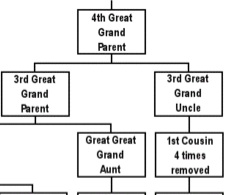 A lot of people, even some genealogy enthusiasts, can get confused about how they’re related to extended relatives. Last week, the popular website Lifehacker posted an article called “Second Cousins” “Once Removed”, and more Explained in Chart.
A lot of people, even some genealogy enthusiasts, can get confused about how they’re related to extended relatives. Last week, the popular website Lifehacker posted an article called “Second Cousins” “Once Removed”, and more Explained in Chart.
My husband, Barry, and I were discussing that article at dinner and he said he didn’t understand why such a complicated chart and long article was necessary. “It’s very simple to figure out,” he said.
“Show me,” I replied. (I live in Missouri, after all.)
So he did. And it was simple.
Herewith, Barry’s method for figuring out how you’re related to someone. There are four steps.
- Figure out the ancestor you have in common with the person in question.
- Count the number of times you say “great” and “grand” in describing that person. (For example, my great great great grandmother would be four, one for each great and grand.)
- Do the same with the person you’re trying to figure out your relationship to. (For example, if the common ancestor is that person’s great great grandmother, their number is three.)
- Look at the numbers. Whichever is lower, that’s the degree of cousins, and the difference between the the two numbers is the removal. So in this example, that relative is my third cousin, once removed.
Try it. It’s really easy! And I think it’s a lot simpler than trying to follow the chart on Lifehacker.
